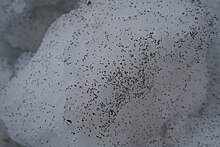Snow flea
| Snow flea | ||||||||||||
|---|---|---|---|---|---|---|---|---|---|---|---|---|
|
Snow flea (Isotomidae gen. Sp.) |
||||||||||||
| Systematics | ||||||||||||
|
||||||||||||
| Scientific name | ||||||||||||
| Desoria hiemalis | ||||||||||||
| ( Schött , 1893) |
As snow fleas several species are wingless Sechsfüßer from the order of springtails referred to on snow surfaces dark by their body coloration, the hopping locomotion and often draw attention through mass occurrences in coming. Common winter-active forms on snow in Europe are, for example, Ceratophysella sigillata, Desoria hiemalis, Desoria violacea, Hypogastrura socialis and Vertagopus westerlundi , and frequent snow collembolas in North America e.g. B. Hypogastrura harveyi and H. nivicola . In mountainous areas there are partly the same, partly related species on snow surfaces, which are then referred to as "glacier fleas" (e.g. V. westerlundi ).
Typically, snow fleas live in moist forests, preferably under conifers . It is known from Desoria hiemalis that the species occurs in a summer and a winter form, which can also be distinguished morphologically. The summer morph lives in the litter, the winter morph migrates to the snow surface at temperatures above −3 ° C. Sunlight and high humidity promote daytime activity in winter. The animals move in a directed way over the snow, use the polarized light and landmarks of the environment for orientation and reach top speeds of up to 120 cm per minute. Most species move more slowly on snow, however, with average speeds of 0.5 to 3 meters per hour. From their main food, coccal algae , the Collembola obtain high-molecular “antifreeze” proteins that improve their ability to cool down and thus their protection against freezing. These glycine- rich proteins bind to newly forming ice crystals and thus delay the formation of an ice glumerate. With the exception of C. sigillata , winter-active Collembola do not consume food during winter, but live on reserve substances that they have built up in the body in autumn.
On frost-free days from the end of January, countless animals gather in hollows in the snow. 1000 to 10,000 animals per m² are not uncommon for C. sigillata and H. socialis ; Desoria and Vertagopus usually migrate in densities of less than one animal per m². In parts of their range, such as subalpine coniferous forests, the occurrence of these species in the summer half-year is restricted to accumulations of moist coniferous litter. The migrations presumably serve to find new habitats, since the food bases are quickly depleted due to mass reproduction in such small-scale habitats. For hikes over longer distances, the equally smooth and moist snow surface is far better suited for Collembola than any forest floor. Obstacles can be overcome more easily and snow-free habitats can be reached quickly, in which reproduction can begin early. The species Ceratophysella sigillata has been shown to use late winter and spring for spreading, feeding and reproduction, while summer and autumn are spent in dormancy . In addition to temperature, humidity and exposure to light, fluctuations in air pressure are assumed to be controlling factors in the hikes. At a temperature of below −3 ° C, D. hiemalis seeks protection under the snow surface or in the ground, at less than −7 ° C the species becomes paralyzed. The cold tolerance of winter-active Collembola varies between −2 and −44 ° C depending on the species.
See also
Individual evidence
- ↑ S. Hågvar (2000): Navigation and behavior of four Collembola species migrating on the snow surface. Pedobiologia 44: 221-233.
- ^ J. Zettel (1984): Cold hardiness strategies and thermal hysteresis in Collembola. Revue d'Ecologie et de Biologie du Sol 21: 189-203.
- ↑ J. Zettel (1985): The cyclomorphosis of Isotoma hiemalis (Collembola): Endogenous control, phenological and physiological aspects. Zoological yearbooks for systematics 112: 383–404.
- ^ HJ Schulz (2006): On the morphology and biology of Hypogastrura socialis (Insecta, Collembola). Microcosm 95: 207-209.
- ↑ J. & U. Zettel (2008): Some like it cold: the biology of the "snow flea " Ceratophysella sigillata (Uzel, 1891), a winter-active springtail species (Collembola: Hypogastruridae). Announcements of the Natural Research Society in Bern 65: 79-110.
- ^ J. Zettel (1984): The significance of temperature and barometric pressure changes to the surface activity of Isotoma hiemalis (Collembola). Experientia 40: 1369-1372.
- ^ W. Block & J. Zettel (1980): Cold hardiness of some Alpine Collembola. Ecological Entomology 5: 1-9.


